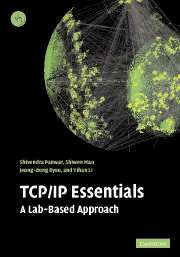Book contents
- Frontmatter
- Contents
- Preface
- Acknowledgements
- General conventions
- List of abbreviations
- 0 TCP/IP overview
- 1 Linux and TCP/IP networking
- 2 A single segment network
- 3 Bridges, LANs and the Cisco IOS
- 4 Static and dynamic routing
- 5 UDP and its applications
- 6 TCP study
- 7 Multicast and realtime service
- 8 The Web, DHCP, NTP and NAT
- 9 Network management and security
- References and further reading
- Appendix A Instructor's guide
- Appendix B Initial configuration of the routers
- Appendix C Source code
- Appendix D List of key requests for comments (RFC)
- Index
8 - The Web, DHCP, NTP and NAT
Published online by Cambridge University Press: 05 June 2012
- Frontmatter
- Contents
- Preface
- Acknowledgements
- General conventions
- List of abbreviations
- 0 TCP/IP overview
- 1 Linux and TCP/IP networking
- 2 A single segment network
- 3 Bridges, LANs and the Cisco IOS
- 4 Static and dynamic routing
- 5 UDP and its applications
- 6 TCP study
- 7 Multicast and realtime service
- 8 The Web, DHCP, NTP and NAT
- 9 Network management and security
- References and further reading
- Appendix A Instructor's guide
- Appendix B Initial configuration of the routers
- Appendix C Source code
- Appendix D List of key requests for comments (RFC)
- Index
Summary
The dream behind the Web is of a common information space in which we communicate by sharing information.
Tim Berners-LeeObjectives
The HyperText Transfer Protocol and the Apache web server.
The Common Gateway Interface.
The Dynamic Host Configuration Protocol.
The Network Time Protocol.
The Network Address Translator and the Port Address Translator.
An introduction to socket programming.
The HyperText Transfer Protocol
The HyperText Transfer Protocol and the Web
In the early days of the Internet, email, FTP, and remote login were the most popular applications. The first World Wide Web (WWW) browser was written by Tim Berners-Lee in 1990. Since then, WWW has become the second “Killer App” after email. Its popularity resulted in the exponential growth of the Internet.
In WWW, information is typically provided as HyperText Markup Language (HTML) files (called web pages). WWW resources are specified by Uniform Resource Locators (URL), each consisting of a protocol name (e.g., http, rtp, rtsp), a “://”, a server domain name or server IP address, and a path to a resource (an HTML file or a CGI script (see Section 8.2.2)). The HyperText Transfer Protocol (HTTP) is an application layer protocol for distributing information in the WWW. In common with many other Internet applications, HTTP is based on the client–server architecture. An HTTP server, or a web server, uses the well-known port number 80, while an HTTP client is also called a web browser.
- Type
- Chapter
- Information
- TCP/IP EssentialsA Lab-Based Approach, pp. 159 - 186Publisher: Cambridge University PressPrint publication year: 2004



